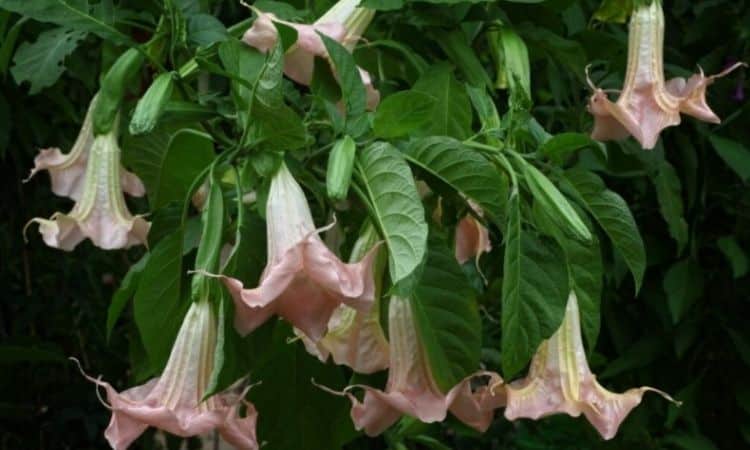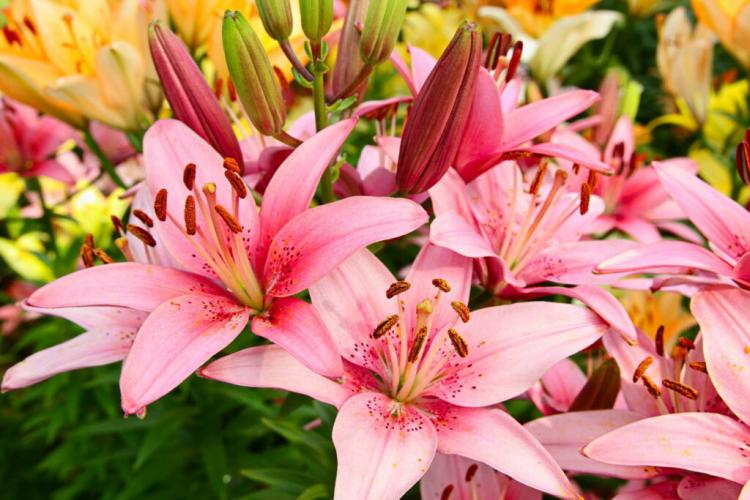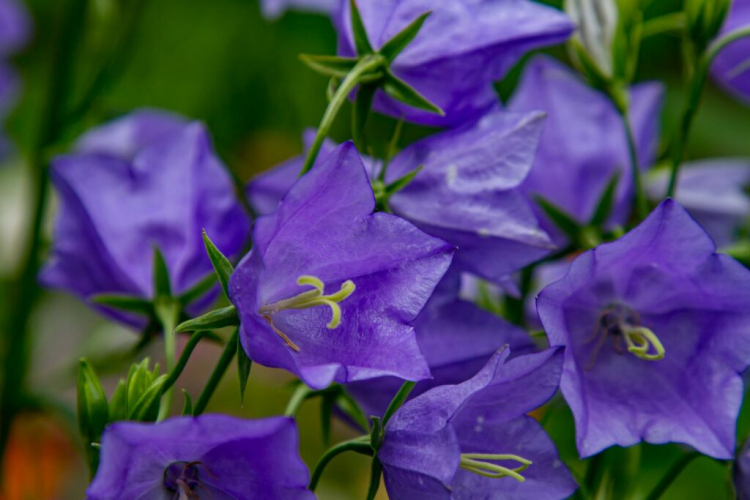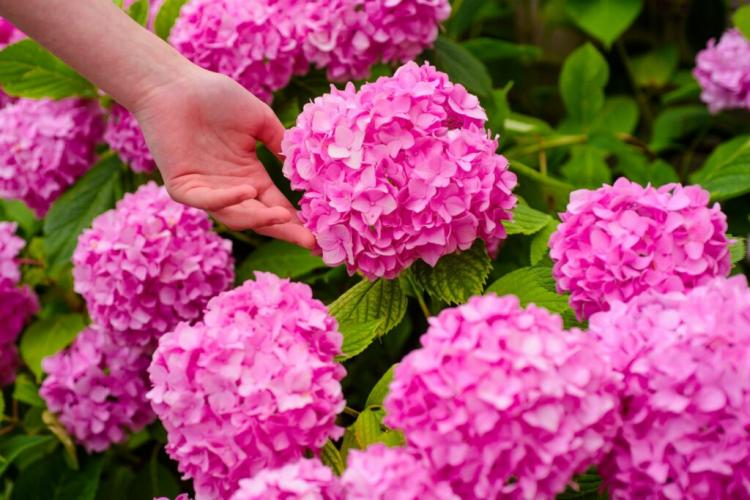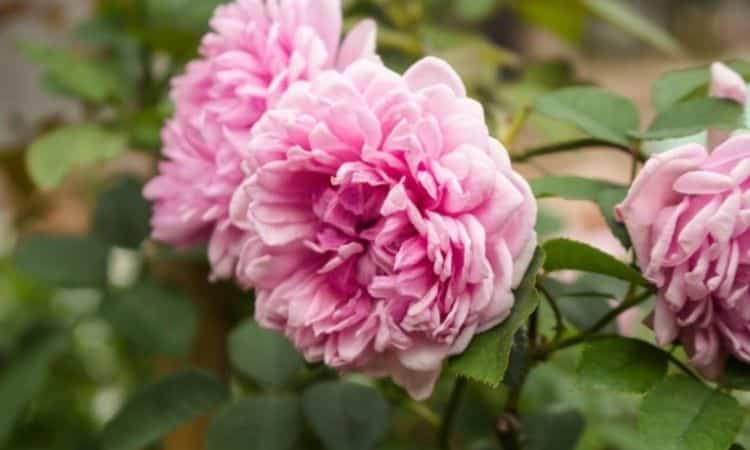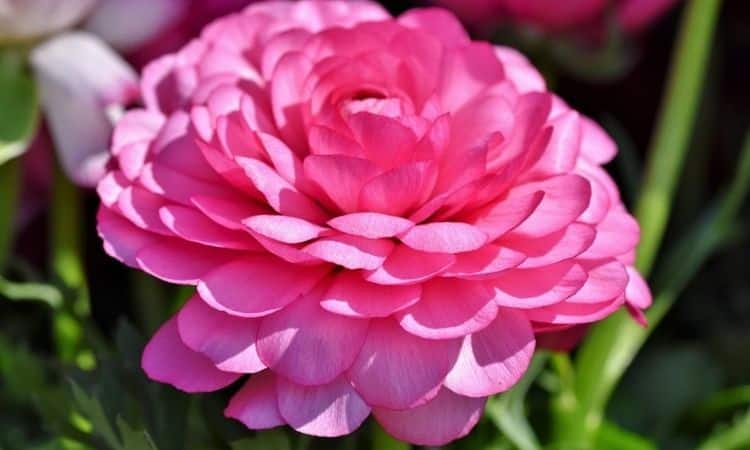Angel Trumpets: Wintering, Propagation, Cutting
Which location is best suited for angel trumpets (also called Brugmansia or trumpet plant)? Are angel trumpets hardy? We reveal everything about planting and caring for the angel trumpet.
Just the affectionate name of this plant genus suggests how much admiration is shown for it: Angel trumpets (Brugmansia) are extremely popular ornamental plants. They are also very popular in collector and breeder circles. The shrub- or tree-shaped trumpet plants can be kept excellently as potted plants and embellish every home.
Angel trumpets do not only enchant with their blossom splendor but also exude a beguiling scent. This is to be heard however only in the late evening and night hours. You receive further exciting facts and care tips approximately around the angel trumpet in our detailed plant portrait.
Angel Trumpets: Flowering Time, Origin, and Characteristics
Table of Contents
The beautiful trumpet plants are not indigenous. They originally come from South America, where they thrive in the open air at various altitudes. The angel trumpet was introduced to Europe as an ornamental plant and is mainly kept there as a tub plant due to the climatic conditions.
In the Mediterranean area, some cultivars can survive in the open field. The tree- or shrub-shaped plants grow to a height of between 2 and 5 meters and usually form hanging, calyx-shaped flowers. The flowering time, scent, and color of the flowers vary greatly between the different varieties.
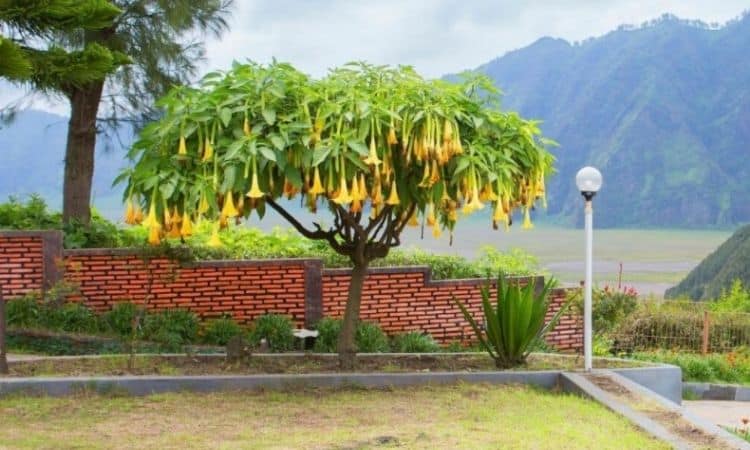
Angel Trumpet Types: Colorful Angel Trumpets For The Garden
The genus Brugmansia contains numerous wild species and cultivated varieties. Often there are also hybrid forms, which were bred from different species. Each variety has different characteristics and is therefore differently suitable for different types of husbandry. In the following, we present you with a colorful selection of colorful angel trumpets.
White Varieties Of The Trumpet Flower
Brugmansia arborea belongs to the classic white angel trumpets. This wild species originally comes from the Colombian Andes and is therefore a quite robust angel trumpet. The plant has rather small, about 15 cm long flowers, which are less luxuriant but bloom quite early in the year. In addition, this trumpet plant exudes a beguiling, flowery scent.
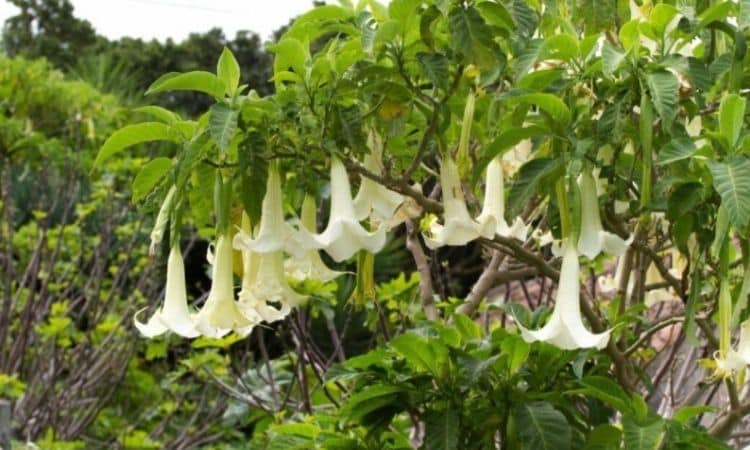
Another white angel trumpet is the hybrid Brugmansia x candida, which was crossed from the species Brugmansia Versicolor and Brugmansia aurea. The “White Angel Trumpet” is a very flowering and robust variety, which can sometimes withstand bad weather conditions well. The cross is therefore a very popular trumpet plant, which is also well suited for beginners.
Red Angel Trumpets
Brugmansia sanguinea originally comes from Colombia and Chile. The species smells only very little, but it beguiles with long, red flowers and is therefore also called the blood-colored angel trumpet. A special feature of this variety is also its flowering time:
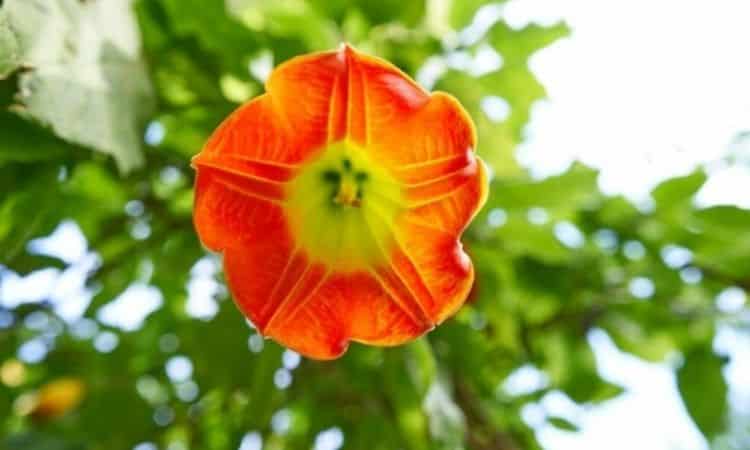
Purple Angel Trumpets
The hybrid Brugmansia x Flava does not have such a beguiling scent as its sisters. Instead, the variety enchants with long, tubular, dark purple to red flowers that shine mainly in spring and autumn. However, as the hybrid is very susceptible to diseases and incorrect care, it is also more suitable for more experienced amateur gardeners.
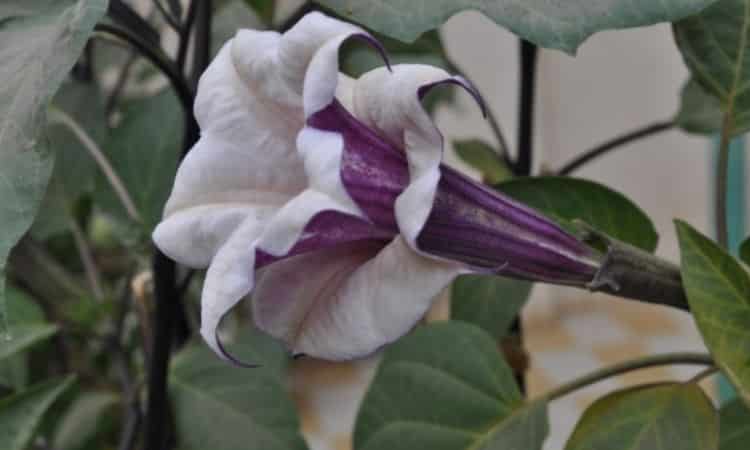
Yellow Angel Trumpets
Brugmansia aurea is also called the Golden Angel Trumpet because of its mostly yellow, rarely white flowers. The species, which originally comes from Ecuador, grows up to 6 m high, bears large, bright flowers, and exudes a pleasant scent. Unfortunately, Brugmansia aurea is often attacked by pests in our country.
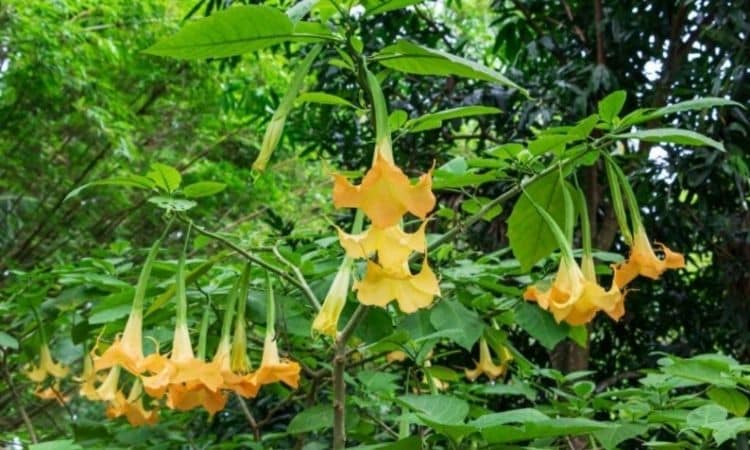
Also, the Brugmansia suaveolens often shines in tender or more intensive yellow tones. In this species, the color is not always clear and can vary from white to yellow to pink. But it is very undemanding and well suited for beginners. In addition, the plant exudes a very intense smell and is therefore also called the Fragrant Angel Trumpet.
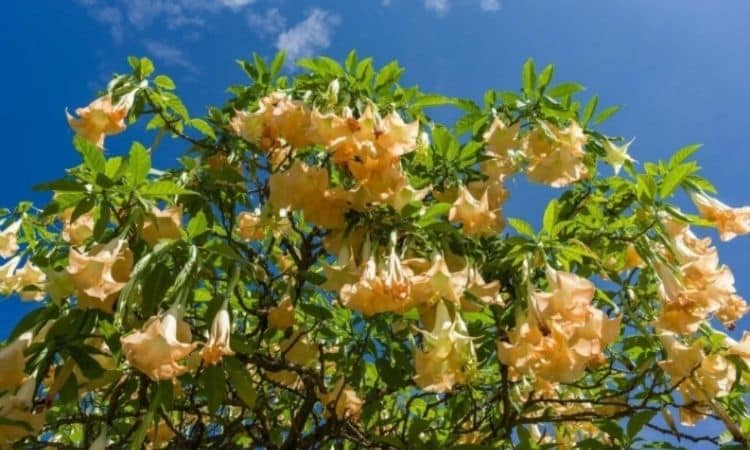
Angel Trumpet Planting: Location, Earth
Angel trumpets are frugal in the choice of location and earth. Basically, any kind of potting soil can be used. However, since the trumpet plants have a high water requirement in summer and especially on hot days, an earth with a good water reservoir and little cuttings is a good choice. For this purpose, many choose peaty soil.
However, consider this step carefully, because peat has many questionable and environmentally harmful properties: When the raw material is mined, large amounts of carbon dioxide are released and valuable ecosystems are destroyed. Therefore, you should water more often on hot days and use peat-free soil – such, which is not only 100% peat-free, but also particularly sustainable and reduces CO2 emissions by up to 60% compared to conventional soils.
Although many breeds tolerate direct sunlight well, angel trumpets thrive best in partial shade. There the loss of water on hot days can also be somewhat reduced. Ideally, the plant should also be protected from too much weather, as heavy rain and hail can quickly damage the sensitive leaves.
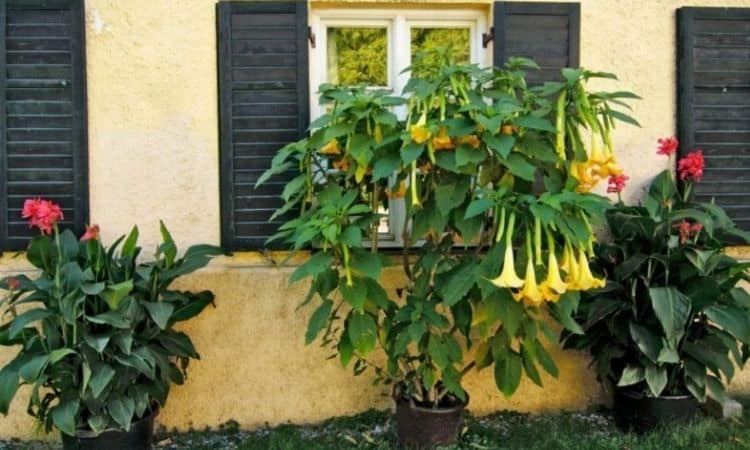
Angel Trumpet Care: Our tips for the Brugmansia
As already mentioned, Brugmansia needs a lot of water in summer. Water regularly, but avoid waterlogging. You will soon notice exactly how much water your plant needs because the trumpet plants will quickly lose their leaves if there is a lack of water. This is not a big deal, but it is a clear request to you to water more in the future.
Angel trumpets cutting
Since the trumpet plants can grow several meters tall, regular pruning of the plants is recommended. It is best to cut back your angel trumpets radically in the late year before wintering. The desired size of the plant should be determined very early, as only the new, still green branches should be cut off. The older, lignified areas, on the other hand, should be avoided, as otherwise the growth will be radically slowed down at this point. As a precaution, wear gloves when cutting the poisonous plant.
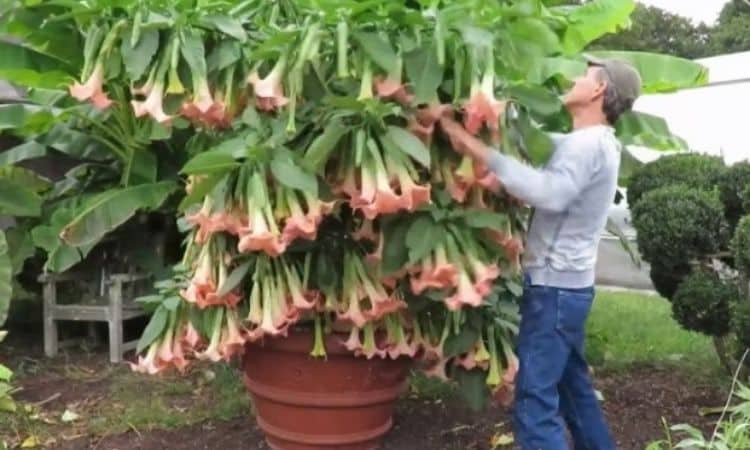
Fertilizing
All Brugmansia varieties need a lot of nutrients and therefore need to be fertilized regularly. Fertilization should be started at the beginning of the growth phase in March or April. A normal plant fertilizer can be used throughout the summer, or a special growth fertilizer can be added at the beginning. For a strong growth pattern and magnificent flowers, a generous amount of fertilizer should be used – overfertilization is almost impossible.
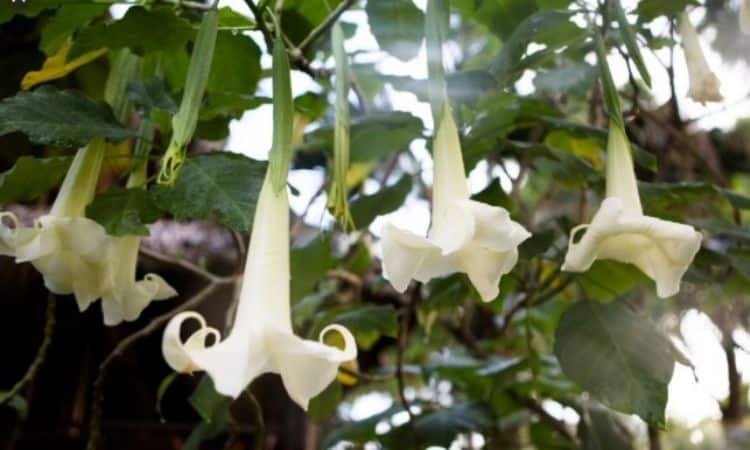
Propagate
Angel trumpets can be propagated by seeds as well as by cuttings. However, the way via cuttings is the easier way and therefore better suited for beginners. In the following, we will tell you how to propagate your favorite trumpets.
Sow angel trumpet seeds
If you want to propagate your trumpet plant via seeds, you can collect them from the flowers and dry them over the winter. Be careful with hybrid varieties: you never know what characteristics the new plants will develop. However, the seeds can also be easily purchased from specialist shops.
For sowing, the seeds must first be soaked in water for 24 hours and can then be converted into growing soil. Always keep the soil warm and moist afterward. You can also cover the containers with glass or transparent foil, but make sure to air them regularly to prevent mold. The germination period can vary between a few weeks and 2 months, depending on the variety and season.

Propagate angel trumpet through cuttings
The propagation of angel trumpets via cuttings is possible all summer long. To do this, simply cut pieces of about 10 cm in size from the crown of the tree, remove the lowest leaves and dip the stems about 4 cm deep into the growing earth. Keep the cuttings in semi-shade at about 20°C and moisten the soil without creating stagnant moisture.
After 3 – 4 weeks enough roots should have formed so that the cuttings can be repotted. However, the cuttings can also be used as cuttings in the late year and overwintered together with the mother plant. In spring, enough roots should have formed in this way.
Angel Trumpet Hibernates: Is The Trumpet Plant Hardy?
Angel trumpets are not hardy. This is also the reason why these beautiful ornamental plants are mainly kept in tubs. The angel trumpet can also be planted directly in the garden, but this makes the wintering process a bit more complicated. As a potted plant, the trumpet plant can easily be moved to a suitable wintering location, such as a garage or cellar.
Make sure the minimum temperature is around 10°C. In addition, water your Angel Trumpet only about once a week in winter and avoid too much moisture. To prevent fungal infestation, sufficient ventilation should also be ensured.

Are Angel Trumpets Poisonous?
Angel trumpets belong to the nightshade family and, like many other plants in this group, contain poisonous alkaloids. This problem applies to all parts of the plant, which is why gloves should be worn when cutting back and contact with food should be avoided.
The plant should also not be eaten. In some cultures, Brugmansia is also used as an intoxicant, as it is said to cause hallucinations and an ecstatic state. However, since the wrong dosage can also lead to symptoms of poisoning in this case, it is also not recommended.
Common Diseases And Pests Of The Angel Trumpet
Particularly the rather more sensitive kinds of the angel trumpet are susceptible to virus or fungal diseases. The latter can be avoided by the correct care and sufficient ventilation at the location. In addition, also feeding enemies, like caterpillars, aphids or snails make themselves gladly at angel trumpets to create. Locusts leave particularly large feeding damage and should therefore be removed immediately.
